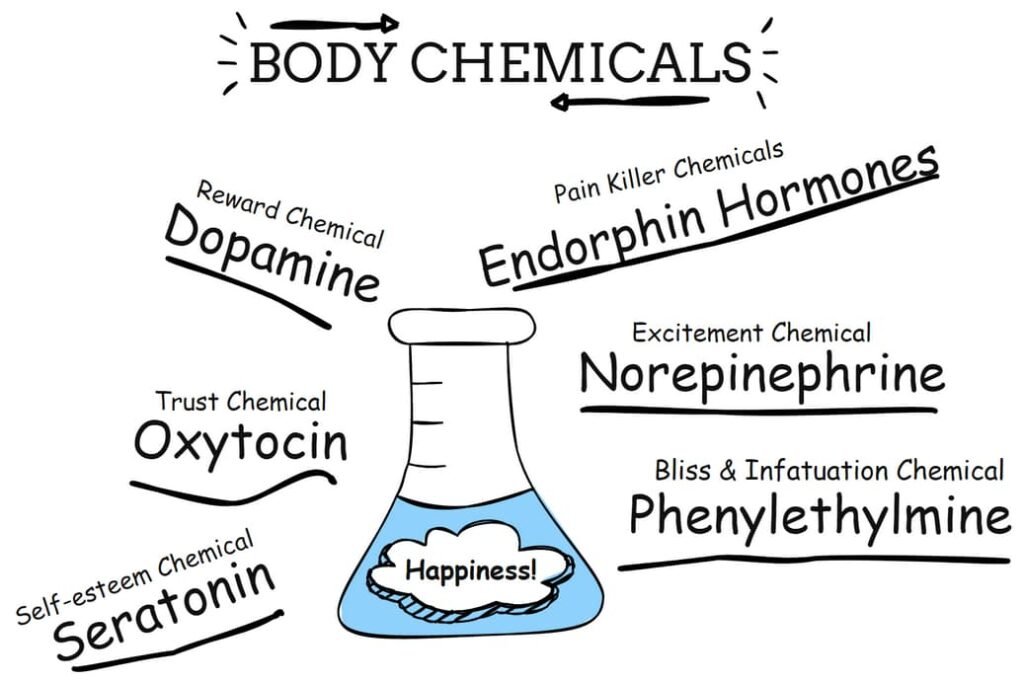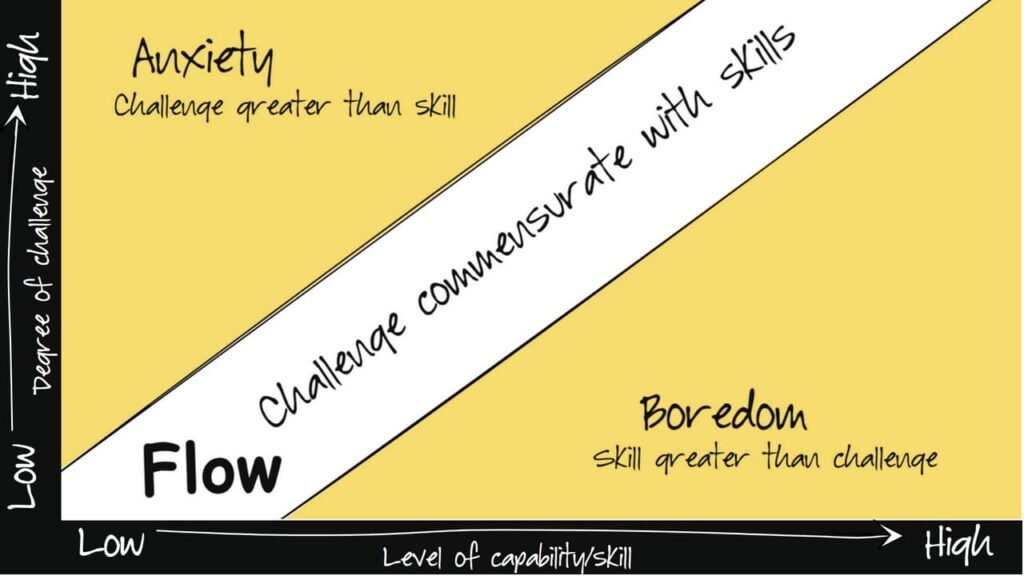
Being able to obtain a state of flow is arguably one of the most important skills anyone could learn.
In flow state we can accelerate learning, enjoy tasks much more, and actually lose track of time because we’ve entered a semi state of bliss and harmony. Too many people seek these feelings from artificial methods by using medications and alcohol. It doesn’t need to be that way.
If you know someone with an addiction to substances please share this with them.
There is a way to activate hormones and neurotransmitters naturally.
Mihaly Csikszentmihalyi’s theory of flow describes a state of complete absorption and focus in an activity, where one loses track of time and experiences a sense of enjoyment and fulfillment. The six neurotransmitters that are believed to be involved in this state are:
- Dopamine: This neurotransmitter is involved in motivation and reward, and is thought to play a role in the feeling of pleasure and satisfaction that comes with achieving a flow state. It is involved in the reward and pleasure centers of the brain. It is also involved in motivation, movement, and attention.
- Norepinephrine: This neurotransmitter is involved in the body’s stress response and can increase arousal and focus, which may be helpful in achieving a flow state. This is a neurotransmitter that is involved in the body’s “fight or flight” response to stress. It increases heart rate, blood pressure, and breathing rate.
- Serotonin: This neurotransmitter is involved in mood regulation and may play a role in the feelings of calm and contentment that can accompany a flow state. It is involved in appetite and sleep. It’s often targeted by medications used to treat depression and anxiety.
- Anandamide: This neurotransmitter is similar to the active ingredient in marijuana and is involved in pain relief and feelings of relaxation.
- Endorphins: These are hormones that act as natural painkillers and can produce a sense of euphoria. They may be released during activities that lead to a flow state. These are hormones that are released by the body in response to stress or pain.
- GABA: This neurotransmitter is involved in reducing anxiety and promoting relaxation, which may be helpful in achieving a flow state.

It’s worth noting that the exact role of these neurotransmitters in achieving a flow state is not fully understood and may vary depending on the individual and the activity involved. You may want to search the work done by Steve Kotler who has done lots of research on Flow states.
A bodily state of being that’s been popularly called an “in the zone” state of mind is called “flow” by psychologist Mikhail Csíkszentmihályi. Being in the zone is about doing tasks as well as practicing mindfulness, which helps generate flow experiences directly.
While in the state of flow, here’s what you experience:
- You feel at peace and at one with the world.
- You let go of your sense of individualism as well as relax and release worries and problems.
- You will become completely focused.
- You feel very satisfied and experience a calming effect with what you’re doing.
- You’re happy for the sake of just being and existing in the moment.
- You release feelings of need and want which centers you.
Csíkszentmihályi’s research found some key factors that yolk together with the experience of flow. When you learn to do a task mindfully, it’s usually going to give you an experience of flow.
Mindfulness creates the experience of flow
Flow experiences need attention, and mindfulness is all about attention. Mindfulness significantly increases your level of attention with practice.
Attention is the IQ of the 21st century. I can easily make this statement with confidence because we have more things breaking our attention span than ever in human history. By practicing the methods of mindfulness regularly, your brain becomes better at paying attention to what you want and need to focus on.
By being able to command your attention you will be making a flow experience far more likely. An example is when driving and having complete attention on your surroundings, instead of allowing your mind to wander off into last weeks office meeting.
You will be getting direct and immediate feedback. This is crucial because Flow needs direct feedback as to how you’re doing.
Through practicing mindfulness you’re getting immediate feedback because you know second by second if you’re paying attention, or if your mind is wandering again. This means when you’re driving and notice your mind has drifted into day dreaming about what you’re going to do for your anniversary, you bring attention gently back to the immediate moment.
By performing a challenging task and using mindfulness you are participating in an active process of repeatedly rebalancing your mind to come back to the present moment. Our mind naturally wants to pull us away into other thoughts.
A good exercise would be to drive in a mindful way from work to home. This is a simple challenge for anyone to create a flow experience. Once you’ve done this successfully—entered into flow—then you can do it again but with different tasks. Eventually you will be able to learn faster and complete complex tasks more proficiently. It’s a win all the time.
You feel a deep sense of personal control. When you’re using mindfulness with your thoughts and feelings you are in more control of your emotions and naturally create a choice of whether to react to them or not.
As you become aware of the choices you generate a sense of control. This translates into a better quality of life because if when driving a vehicle cuts in front of you, you’ve now got a powerful choice. Either to react and feel annoyed, or practice letting it go and focusing on safety and getting to your destination.
You are overwhelmed that what you are doing and where you’re at is intrinsically rewarding. You will begin performing and completing tasks for the experience of just doing them.
For example, if you’re driving your car to get home as quickly as you can so you can begin dinner then you’re not going to be able to obtain a flow experience. If you drive to simply enjoy each moment of the journey, noticing things along the way, that’s changes things. You can appreciate the flowers along the way and feel the warmth of the sunshine on your arm. You will feel gratitude and in control of your moods.
Three other important hormones and body chemicals:
- Oxytocin: This is a hormone that is often referred to as the “love hormone” because it is released during social bonding activities such as hugging, kissing, and sex. It is also involved in childbirth and breastfeeding.
- Phenylethylamine: This is a naturally occurring chemical that is found in chocolate and is believed to have mood-enhancing effects. It is also involved in the release of dopamine in the brain.
- Nitric oxide: Is a compound in the body that causes blood vessels to widen, why many bodybuilders use drinks containing nitric oxide for a pre-workout drink, and stimulates the release of certain hormones like insulin and human growth hormone. Through this process called vasodilation, blood vessels widen and increase circulation. Vasodilation has been shown to increase performance in athletes, decrease blood pressure, and increase blood flow to certain areas of the body like the hands and feet. Nitric oxide is produced in the endothelial cells, the single thick wall of cells that comprise the inner lining of blood vessels. Nitric oxide (NO) works as a retrograde neurotransmitter in synapses, allows the brain blood flow and also has important roles in intracellular signaling in neurons. Nitric oxide is a gas we make within our own bodies from nitrates and nitrites found naturally in our foods. Good sources include dark green leafy vegetables like kale, arugula, Swiss Chard and spinach. Other great sources include beets, cabbage, cauliflower, carrots and broccoli.
As you can see above that many of these work as a precursor in the activation of another, while some work independently. They are also called the “happy hormones”.
These neurotransmitters and hormones are activated while we are at our computer and watching TV too.
How reading a story can have an effect our brain
According to Lisa Cron, who has written several books on the elements of story, is a leader in how to write and understand stories. She says story is like a chemical cocktail to our brain and nervous system. When reading a story we use the following inner body hormones like this:
- dopamine – it has to do with our curiosity and keeps us reading and saying to ourselves, “I’m going to read this to find what happens.”
- cortisol – it’s the stress hormone that keeps us reading because something is at stake and something is at risk in the story. It has to be internal and subjectively dramatic, and not objective.
These two alone won’t keep readers completely involved to the point they can’t put the book down though. The third body hormone that must be involved to give the story or book a five-star rating is oxytocin. It finishes the process of deciding how we feel.
- oxytocin – involved with the emotion of empathy. That there needs to be something visceral to care about in the story, usually a protagonist. To have the most impact this empathy can’t simply be generic. Like the protagonist is about to be beaten with a baseball bat. That’s danger and fear but for the oxytocin to grab the reader the empathy must be more involved.

Recent Posts
Overthinking and ruminating can take a toll on one's mental health and well-being. Fortunately, mindfulness has been proven to be an effective tool for breaking free from these negative habits....
Psychology of Mindfulness: Unlocking the Power of Present Moment Awareness
Are you feeling overwhelmed by the fast-paced world we live in? Do you find yourself constantly worrying about the future or dwelling on the past? The practice of mindfulness may be just what you...
